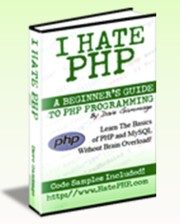
 License Type: Private Label Rights
License Type: Private Label Rights  File Type: ZIP
File Type: ZIP
 SKU: 60852
SKU: 60852  Shipping: Online Download
Shipping: Online Download
Sample Content Preview
First of all, my background and why this book came to be...
Most PHP/MySQL books on the market that I have read were not written for the novice. To be honest, even I struggled with “PHP For Dummies”, although I’ve been working with HTML and another programming environment, ColdFusion, for years. So, WHY was PHP so hard for me? I think it was a number of things, but most of all because with HTML and ColdFusion experience, I was used to a TAG based language. For everything there was a tag, like this:
So, who is this book for?
This book is for the lonely people who can’t get a da...hold on...wrong book...”I Hate PHP” is for webmasters and designers who have always wondered what PHP could do for them; someone who wants to “do” some PHP and not outsource it. It is best to be familiar with HTML and writing / deciphering HTML code. You don’t need to be a top-notch “I do it all in Notepad” kinda person - just being able to open up a text editor and understand the code is enough. Copy / Paste knowledge is helpful too.
Unlike other PHP books on the market, we are not going to attempt to cover every single facet of the Wide World Of PHP Language. No, we want to grasp the basics of the language, get familiar with it, and get some real-life examples...not have the whole thing shoved down our throat!
You’ll find that throughout this book, my odd sense of humor may shine through a little bit. You might not find that web programming is the most exciting thing on the planet. Well, I don’t either, so I tried to make it interesting and easy to read.
More Places To Learn
At the end of the book, we’ll include some links to other websites and products that will help you on your journey to PHP mastery. We’re not endorsing them...just providing them. You must walk the path, young grasshopper.
Presentation
The examples in this book are presented in 3 levels - The Easy Stuff, The Not So Easy Stuff, and Oh Man Not MySQL!
The Easy Stuff consists of common PHP commands you can use on just about any site you build. The Not So Easy Stuff is code that is a little more difficult to grasp, but you might still want to use it. Oh Man Not MySQL! will cover - you guessed it - how to connect to a MySQL database and do basic things, like writing to it and retrieving information.
And now, without futher ado....
Covering ECHO, STRING, DATE, VARIABLES, INCLUDE, REQURE, and HEADER
Before we get into learning how to use PHP, we need to briefly explore what PHP is...but I’m not going to go into some long drawn out history of PHP and why it’s here. Also, it is good to be familiar with HTML before you proceed, as you will need to be able to copy and paste code in web pages.
In the world of the wide web, there are two general types of coding languages: “Server side” and “Client side”. This means that one type is run, or interpreted, on the web server itself, and the other is run in your web browser.
PHP is a Server side language. All of the processing is done on the web server itself, and the result is delivered to your web browser as HTML (which, by the way, is a Client side language). Your web server must also have PHP installed in order for it to work! Most web hosting providers have PHP installed, so if you are in doubt, simply ask them.
Now, Let’s Code!
We’re going to tackle the basics to start with. Getting PHP to write things to the web browser, what variables are and how to use them...examples you can use in just about every web page you create.
Let’s start with the most basic one.
The PHP Echo command
We’re going to tell PHP to output something to the screen. Keep in mind that PHP can be used in conjunction with HTML, but we are not showing the code in this example, to keep it simple:
(I hate the “Hello World” sample that every other book in the world uses, so I’m using “Creamy Bagels” instead.)
- License: Private Label Rights
- Category:Ebooks
- Tags:2008 Ebooks Private Label Rights







